|
|
Visit Us at ART&ANTIQUE
from 9 till 13 November in Vienna
|
Only a few days left until the highlight of the art fair year: From 9 to 14 November ART&ANTIQUE will take place in the Vienna Hofburg. It is Austria's most elegant art fair with the highest quality. As the sole gallery for ancient art we present for the first time the magnificent and published limestone relief of a servant from Palmyra, which we are delighted to introduce as the highlight of the month in this newsletter. What else are we showing in the Hofburg? Three archaic Etruscan antefixes of fascinating beauty, ancient jewellery – and of course also affordable gift inspirations for Christmas.
|
|
Besuchen Sie uns auf der ART&ANTIQUE
von 9. bis 13. November in Wien
|
Nur noch wenige Tage bis zum Höhepunkt des Messejahres: Von 9. bis 13. November findet die ART&ANTIQUE in der Wiener Hofburg statt. Es ist die eleganteste, die hochwertigste Messe Österreichs. Als einzige Galerie für Kunst der Antike präsentieren wir dort erstmals das herausragende und publizierte Kalksteinrelief eines Dieners aus Palmyra, das wir in diesem Newsletter als Highlight des Monats vorstellen dürfen. Was wir in der Hofburg sonst noch zeigen? Gleich drei archaische etruskische Antefixe von faszinierender Schönheit, antiken Schmuck – und natürlich auch leistbare Geschenkideen für Weihnachten.
|
|
|
|
Our Highlight of the Month:
|
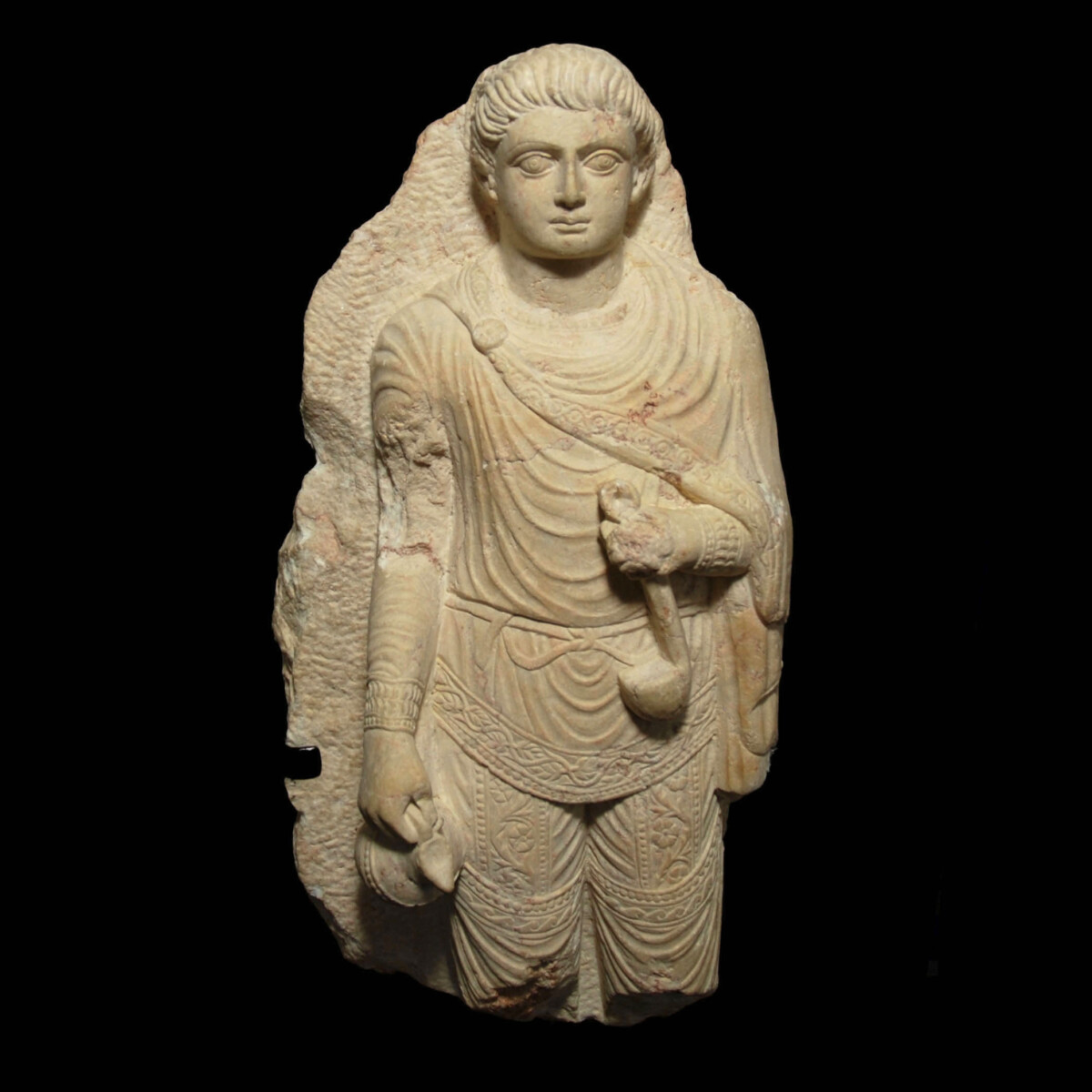
|
|
|
|
|
|
Roman Empire/Palmyra – 220-240 A.D.
|
Large fragment of the lower part of a limestone sarcophagus from Palmyra depicting a young servant in a traditional Parthian costume. He looks straight ahead, has a strong neck and even, fine facial features with the large eyes with elaborate irises and pupils that are typical for Palmyran art. His short, stringy hair is coiffed into the forehead. The young man wears a cloak that is knotted on his right shoulder and falls in folds over the left side of his body. Underneath a short tunic with a belt around the belly, which semi-circularly finishes with a hemline, which is adorned with leaf tendrils. On the wrists the vestment is decorated with dots- and wave decoration. The young man wears trousers in oriental tradition, which are decorated with vertical decorative ribbons depicting tendrils and floral motives, finishing again with dots- and wave bands. The servant holds in his left hand a simpulum in front of his belly. His right hand hangs down and holds a wine jug decorated with dotted rows. The extremely detailed and finely crafted, very sculptural relief is one of a series of servant figures that adorned the lower long side of a sarcophagus. The depiction of the deceased laid over the entire length on the lid of sarcophagus in banquet position on a kline. The relief is published in “Art of the Ancient World”, Vol. XX, p. 22 no 33. See for the depiction of an almost complete sarcophagus the one in the Palmyra Archaeological Museum with the inventory number 2677B/8983. As well as for the sarcophagi in Palmyra: Malcolm Colledge “The Art of Palmyra”, London 1976, p. 77-78. Mounted.
|
Provenance: French private collection prior to 2000, thence in a Californian collection. 2009 with Royal Athena Galleries, New York. Published in “Art of the Ancient World”, Vol. XX, p. 22 no 33. Last in the US art market.
Dimensions: 43 cm high
Price: 40 000 Euro
|
|
|
Römisches Reich – 220-240 n. Chr.
|
Großes Fragment von der Unterseite eines Kalkstein-Sarkophags aus Palmyra, das einen jungen Diener in parthischer Tracht zeigt. Er blickt gerade aus, hat einen kräftigen Hals sowie gleichmäßige feine Gesichtszüge mit den für die Kunst Palmyras typischen großen Augen mit ausgearbeiteter Iris und Pupille. Sein kurzes, strähniges Haar ist in die Stirn frisiert. Der junge Mann trägt einen auf der rechten Schulter verknoteten Umhang, der ihm faltenreich über die linke Körperhälfte fällt. Darunter eine kurze Tunika mit Gürtel um den Bauch, die halbrund mit einem Saum abschließt, der mit Blätterranken geschmückt ist. An den Handgelenken ist das Gewand mit Punkt- und Wellendekor verziert. Der junge Mann trägt in orientalischer Tradition Hosen, die mit vertikalen Schmuckbändern verziert sind, die Ranken und florale Motive zeigen. Den Abschluss bilden wieder Punktreihe und Wellenband. Der Diener hält in seiner linken Hand ein Simpulum vor den Bauch. Seine rechte Hand hängt herab und hält eine mit einer Punktreihe verzierte Weinkanne. Das überaus detailreich und fein gearbeitete, sehr plastische Relief gehört zu einer Reihe von Dienerfiguren, die die untere Längsseite eines Sarkophags zierten. Der Verstorbene selbst lag über die gesamte Länge am Deckel des Sarkophags in Bankettstellung auf einer Kline. Das Relief ist publiziert in „Art of the Ancient World“, Vol. XX, Seite 22, No. 33. Vergleiche zur Darstellung den annähernd kompletten Sarkophag im Palmyra Archaeological Museum mit der Inventarnummer 2677B/8983. Sowie zu den Sarkophagen aus Palmyra: Malcolm Colledge „The Art of Palmyra“, London 1976, S. 77-78. Gesockelt.
|
Provenienz: Französiche Privatsammlung vor 2000, danach in einer kalifornischen Sammlung. 2009 bei Royal Athena Galleries, New York. Publiziert in „Art of the Ancient World”, Vol. XX, p. 22 no 33. Zuletzt im US-Kunsthandel.
Dimensionen: 43 cm hoch
Preis: 40.000 Euro
|
|
|
|
Selected Artworks of the Month:
|
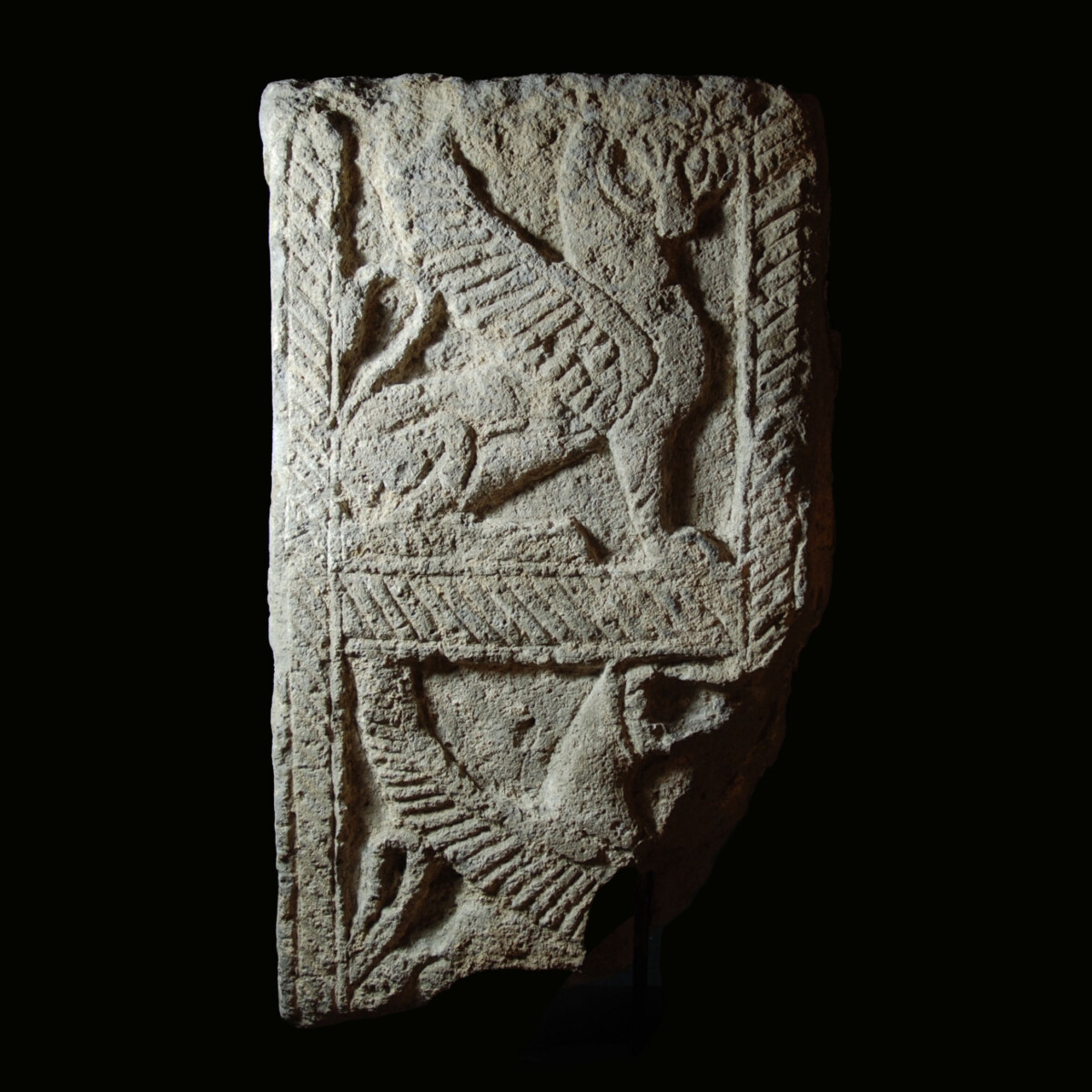
|
|
|
|
Etruria – Early 6th century B.C.
|
Large relief of volcanic Nenfro tuff which belonged to a stair slab relief (“Lastrone a Scala”). The earliest evidence of Etruscan sculptures and relief art from Tarquinia possibly served as door clasps of chamber tombs. The image area depicts on top a sit up, winged panther who looks towards the viewer. His tail is raised and turned outwards. Below also a sit up, winged animal, possibly a lion. His tail is also raised and turned outwards. The lion and panther are typical grave keepers and common motives of stair slab reliefs from Tarquinia. The image areas are framed by fluted strips, which intend to imitate twisted ribbons. At the break point on the right were the sculptural stairs, which owe their name to the stair slab reliefs. See for comparison the stair slab relief in the Museum für Kunst und Gewerbe Hamburg with the inventory number 1999.280, as well as the relief in the Museo archeologico nazionale in Tarquinia (for example inventory number 70814). Mounted on an old metal base.
|
Provenance: From an old Swiss collection. Thence Belgian private collection, acquired 1988 in the gallery Elsa Bloch-Diener in Bern, Switzerland. Last in the French art market.
Dimensions: 64 cm high
Price: 10 000 Euro
|
|
|
Etrurien – Anfang 6. Jahrhundert v. Chr.
|
Großes Relief aus vulkanischem Nenfro-Tuffstein, das zu einem Treppensteinrelief („Lastrone a Scala“) gehörte. Diese frühesten Zeugnisse der etruskischen Skulptur und Reliefkunst aus Tarquinia dienten wohl als Türverschlüsse von Kammergräbern. Die Bildfläche zeigt oben einen aufrecht sitzenden, geflügelten Panther, der seinen Kopf dem Betrachter zuwendet. Er hat seinen Schwanz angehoben und nach außen gedreht. Darunter ein ebenfalls aufrecht sitzendes, geflügeltes Tier, wahrscheinlich ein Löwe. Auch er hat seinen Schwanz angehoben und nach außen gedreht. Der Löwe und der Panther sind typische Grabwächter und häufiges Motiv auf Treppensteinreliefs aus Tarquinia. Die Bildflächen sind von geriffelten Leisten umrahmt, die aufgedrehte Bänder imitieren sollen. An der Bruchstelle rechts schlossen die plastischen Treppen an, die den Treppensteinreliefs ihren Namen verdanken. Vergleiche dazu das Treppensteinrelief im Museum für Kunst und Gewerbe Hamburg mit der Inventarnummer 1999.280 sowie die Reliefs im Museo archeologico nazionale in Tarquinia. Auf altem Metallsockel.
|
Provenienz: Aus alter Schweizer Sammlung. Danach belgische Privatsammlung, erworben 1988 in der Galerie Elsa Bloch-Diener in Bern. Zuletzt im französischen Kunsthandel.
Höhe: 64 cm
Preis: 10.000 Euro
|
|
|
|
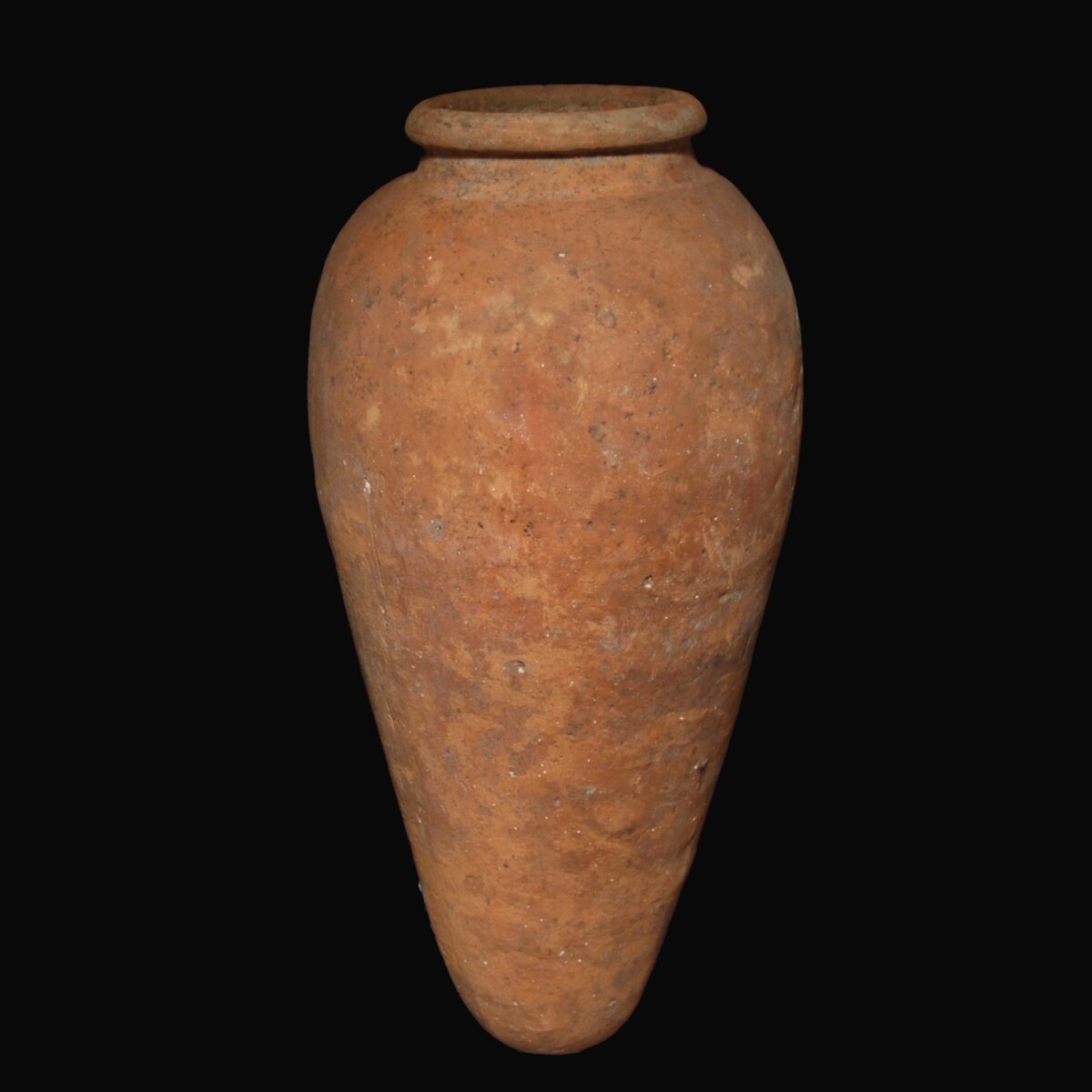
|
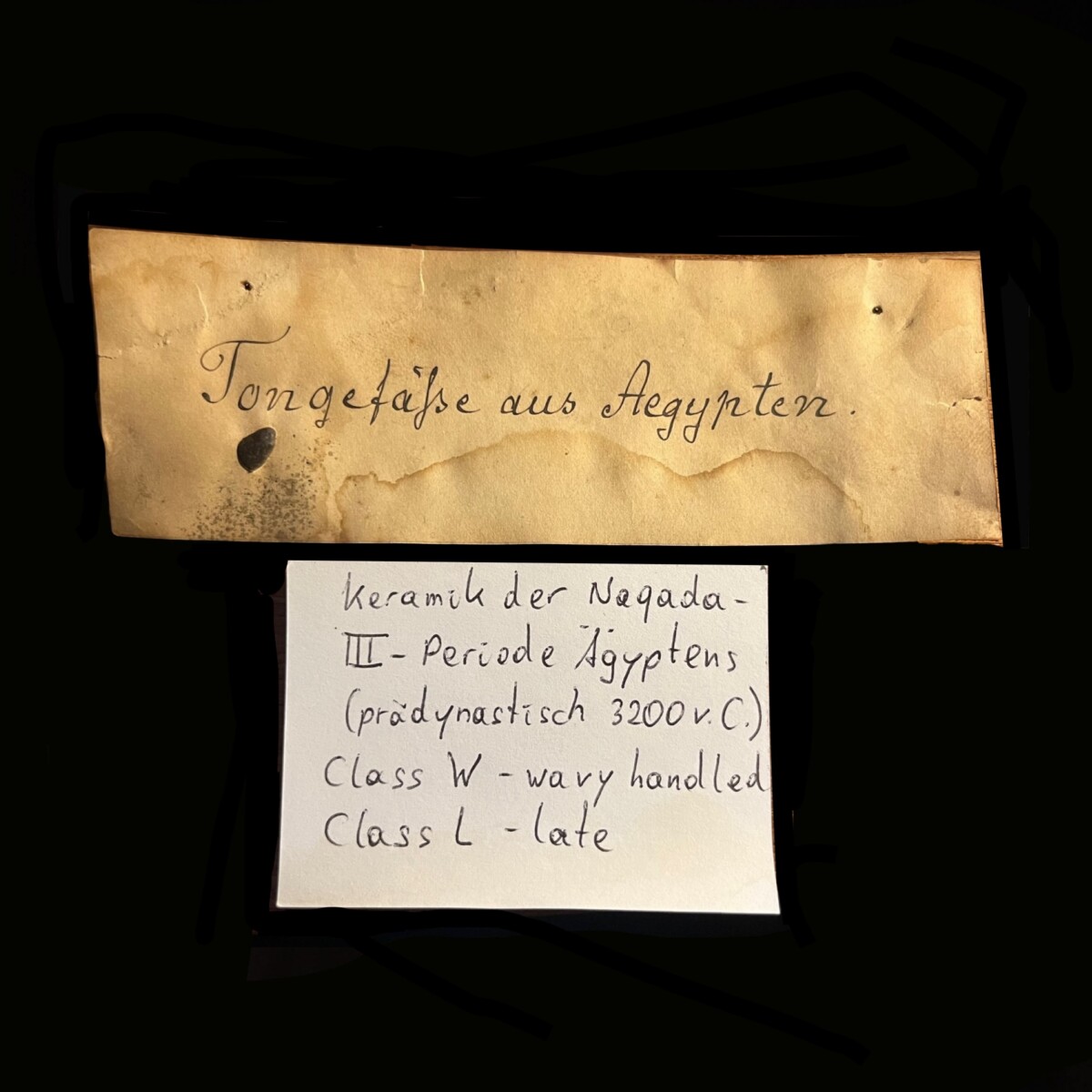
|
|
|
|
Egypt – Naqada II-III period, 3300-3100 B.C.
|
Wonderfully preserved, very large predynastic terracotta vase of the so-called L-Class which served as a storage vessel. The hand-formed vase, which is rounded at the bottom, widens towards the top before narrowing again into a semicircle. The constricted rim was worked out separately and then applied on the body. This is how the short, grooved neck was created, which made it possible to hang the vessel on a cord and carry it with you in nomadic life. See for the type Diane Leeman “An overview of the Predynastic Pottery of Ancient Egypt”, self-published on Academi.edu, p. 24. With a copy of an old, handwritten collection note and a label with the inscription “Tongefäße aus Aegypten” from the early 20th century.
|
Provenance: Possibly old Austrian private collection, early 20th century due to the enclosed label. Thence collection Rudolf Pospischil (1911-1998), southern Germany. Last in a family estate.
Dimensions: 45.4 cm high
Price: 2 400 Euro
|
|
|
Ägypten – Naqada II-III-Periode, 3300-3100 v. Chr.
|
Wunderbar erhaltene, sehr große prädynastische Terrakotta-Vase der sogenannten L-Class, die als Vorratsgefäß diente. Die unten abgerundete, handgeformte Vase verbreitert sich nach oben, ehe sie sich halbrund wieder verjüngt. Der eingeschnürte Rand wurde separat gearbeitet und dann an dem Korpus angebracht. So entstand der kurze, gekehlte Hals, der es erlaubte, das Gefäß über eine Schnur aufzuhängen und im nomadischen Leben mitzuführen. Vergleiche zum Typus Diane Leeman „An overview of tthe Predynastic Pottery of Ancient Egypt“, Self-published on Academia.edu, S. 24. Mit einer Kopie einer alten, handschriftlichen Sammlungsnotiz und einem Etikett mit der Aufschrift „Tongefäße aus Aegypten“ aus dem Anfang des 20. Jahrhunderts.
|
Provenienz: Wohl altösterreichische Privatsammlung, Anfang des 20. Jahrhunderts aufgrund des beiliegenden Etiketts. Danach Sammlung Rudolf Pospischil (1911-1998), Süddeutschland. Seitdem in Familienbesitz.
Höhe: 45,4 cm
Preis: 2.400 Euro
|
|
|
|
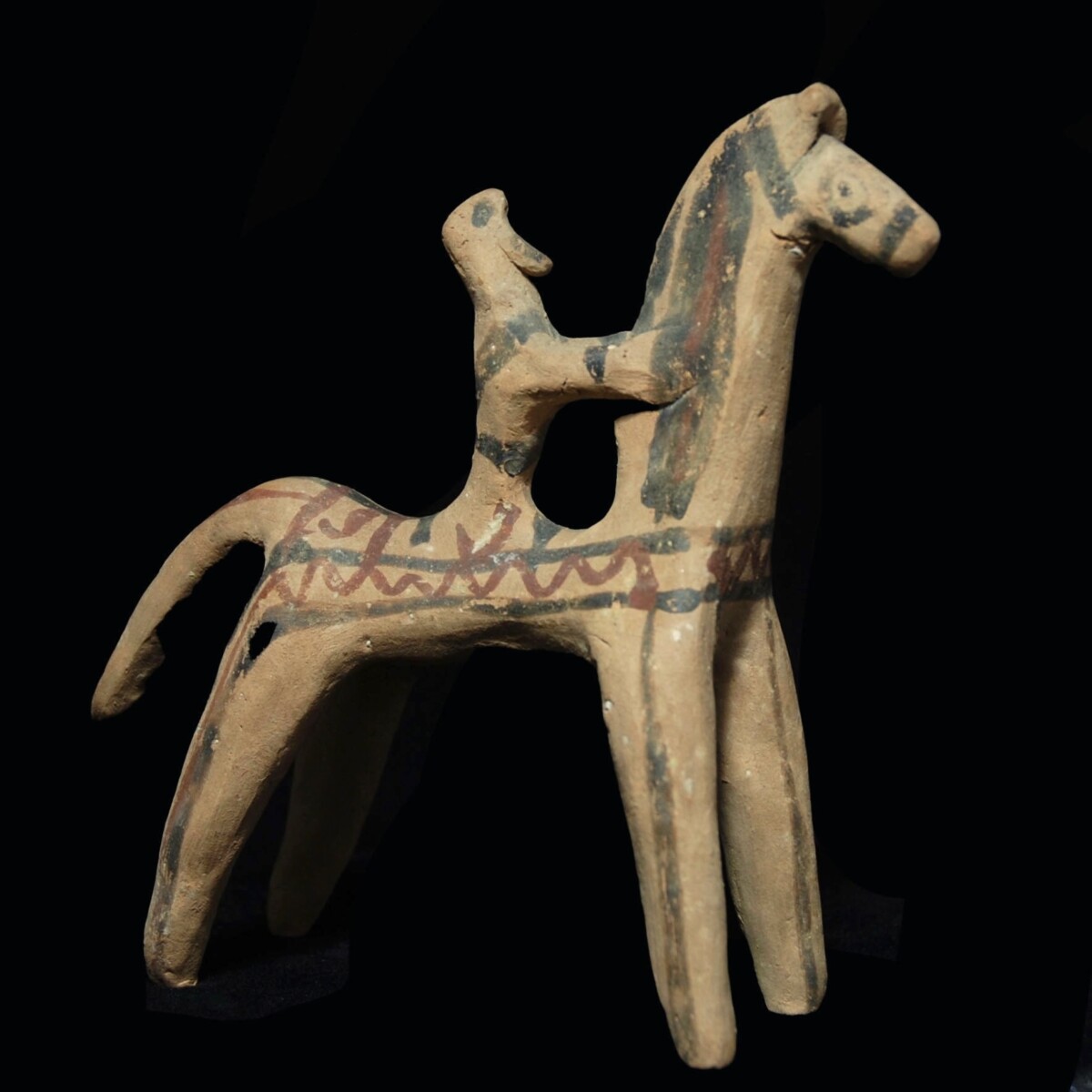
|
|
|
|
|
|
Greece/Boeotia – 6th century B.C.
|
Large, stylized terracotta statuette of a horse with rider. The animal with straight legs, raised and slightly stretched out tail and a semi-circular, pointy mane. The eyes are painted as black dots, framed by a black circle. The body is decorated with red wavy and black lines. The rider, also stylized with a bird’s head, black dotted eyes and long nose, has his arms on the neck of the animal. As if he emerges from the back of the horse, his legs are not worked out. The body of the rider is also decorated with black lines. An old collection number is written in pencil on the underside of the horse on the belly. Statues such as the present one originate from a period where the owner of a horse is associated with a high social rank. They were found in tombs but also in temples. See for the type the statuette in the Museum of Fine Art in Budapest with the inventory number 51.137.
|
Provenance: German private collection J. Gutbrod (dies 2017), acquired in the 1960s to 1990s in the German art market. Thence by descent to Micaela Gutbrod, Munich.
Dimensions: 13.3 cm x 14 cm
|
|
|
Griechenland/Böotien – 6. Jahrhundert v. Chr.
|
Großes, stilisierte Terrakotta-Statuette eines Pferdes mit Reiter. Das Tier mit geraden Beinen, angehobenem und leicht weggestrecktem Schwanz und halbrunder, spitz zulaufender Mähne. Die Augen sind als schwarze Punkte, umrahmt von einem schwarzen Kreis aufgemalt. Der Körper ist mit roten Wellenlinien und schwarzen Linien verziert. Der ebenfalls stilisierte Reiter mit Vogelkopf, schwarz gepunkteten Augen und langer Nase legt seine Arme an den Hals des Tieres. Er entwächst gleichsam dem Rücken des Pferdes, seine Beine sind nicht ausgearbeitet. Der Körper des Reiters ist ebenfalls mit schwarzen Linien verziert. Auf der Unterseite des Pferdes ist am Bauch eine alte Sammlungsnummer mit Bleistift geschrieben. Statuen wie diese stammen aus einer Zeit, in der der Besitz eines Pferdes mit einem hohen sozialen Rang verbunden war. Sie wurden in Gräbern, aber auch in Tempeln gefunden. Vergleiche zum Typus die Statuette im Museum of Fine Arts in Budapest mit der Inventarnummer 51.137.
|
Provenienz: Deutsche Privatsammlung J. Gutbrod (verstorben 2017), erworben in den 1960er bis 1990er Jahren am deutschen Kunstmarkt. Danach durch Erbe an Micaela Gutbrod, München.
Dimensionen: 13,3 cm x 14 cm
Preis: 2.400 Euro
|
|
|
|

|
|
Egypt – New Kingdom, 18th-19th dynasty, around 1450-1189 B.C.
|
Limestone relief with beautiful original colors dating to the New Kingdom, depicting the upper body and arms of Nile God Hapi, who holds an offering table. Parts of vessels are recognizable on the table. Hapi was responsible for the flood of the Nile, which left behind fertile mud and which the Egyptians called the “Arrival of Hapi.” In addition, as the symbol of the life-giving Nile he was worshiped as the creator god and “Father of the Gods”. As god of fertility he was depicted as an androgyn, although being male, as seen in this relief with hanging female breasts and a large belly. The hand posture with the offering table is on numerous reliefs of Hapi, e.g., in the funerary temple of Sethos I on the western Nile bank in Abydos. Mounted.
|
Provenance: With Jean-Loup Despras, gallery Orient Occident 1970. Thence collection Jean Deriat, Paris 2016. Last in the collection Michael Goughassian (1943-2020), Paris, acquired on 20 July 2021 from gallery Cybele. With a copy of the invoice.
Dimensions: 20 cm x 26 cm
|
|
|
Ägypten – Neues Reich, 18. bis 19. Dynastie, ca. 1450-1189 v. Chr.
|
Mit schönen Original-Farben erhaltenes Kalksteinrelief aus dem Neuen Reich, das Oberkörper und Arme des Nilgotts Hapi zeigt, der einen Opfertisch hält. Auf dem Tisch sind Teile von Gefäßen erkennbar. Hapi war verantwortlich für die Nilflut, die fruchtbaren Schlamm zurückließ und die von den Ägyptern „Ankunft des Hapi“ genannt wurde. Als Symbol des lebensspendenen Nils wurde er zudem als Schöpfergott und „Vater der Götter“ verehrt. Als Gott der Fruchtbarkeit wurde er, obwohl männlich, androgyn dargestellt, wie auf diesem Relief mit herabhängenden weiblichen Brüsten und großem Bauch. Die Handhaltung mit dem Opfertisch findet sich auf zahlreichen Reliefs des Hapi, etwa am Totentempel von Sethos I. am westlichen Nilufer in Abydos. Gesockelt.
|
Provenienz: Bei Jean-Loup Despras, Galerie Orient Occident 1970. Danach Sammlung Jean Deriat, Paris 2016. Zuletzt in der Sammlung Michel Goughassian (1943-2020), Paris, erworben am 20. Juli 2021 in der Galerie Cybele. Mit Kopie der Rechnung.
Dimensionen: 20 cm x 26 cm
Preis: 9.000 Euro
|
|
|
|
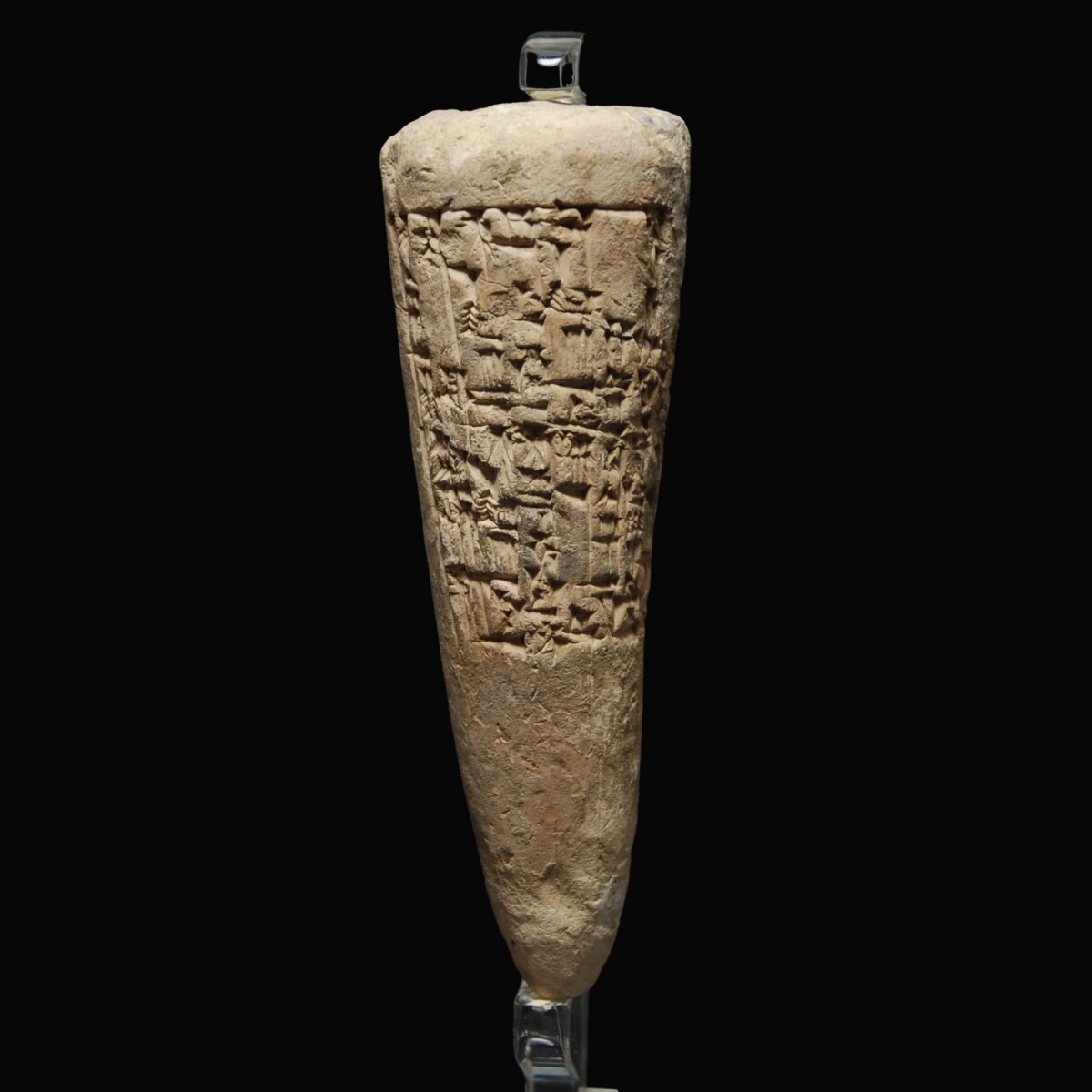
|
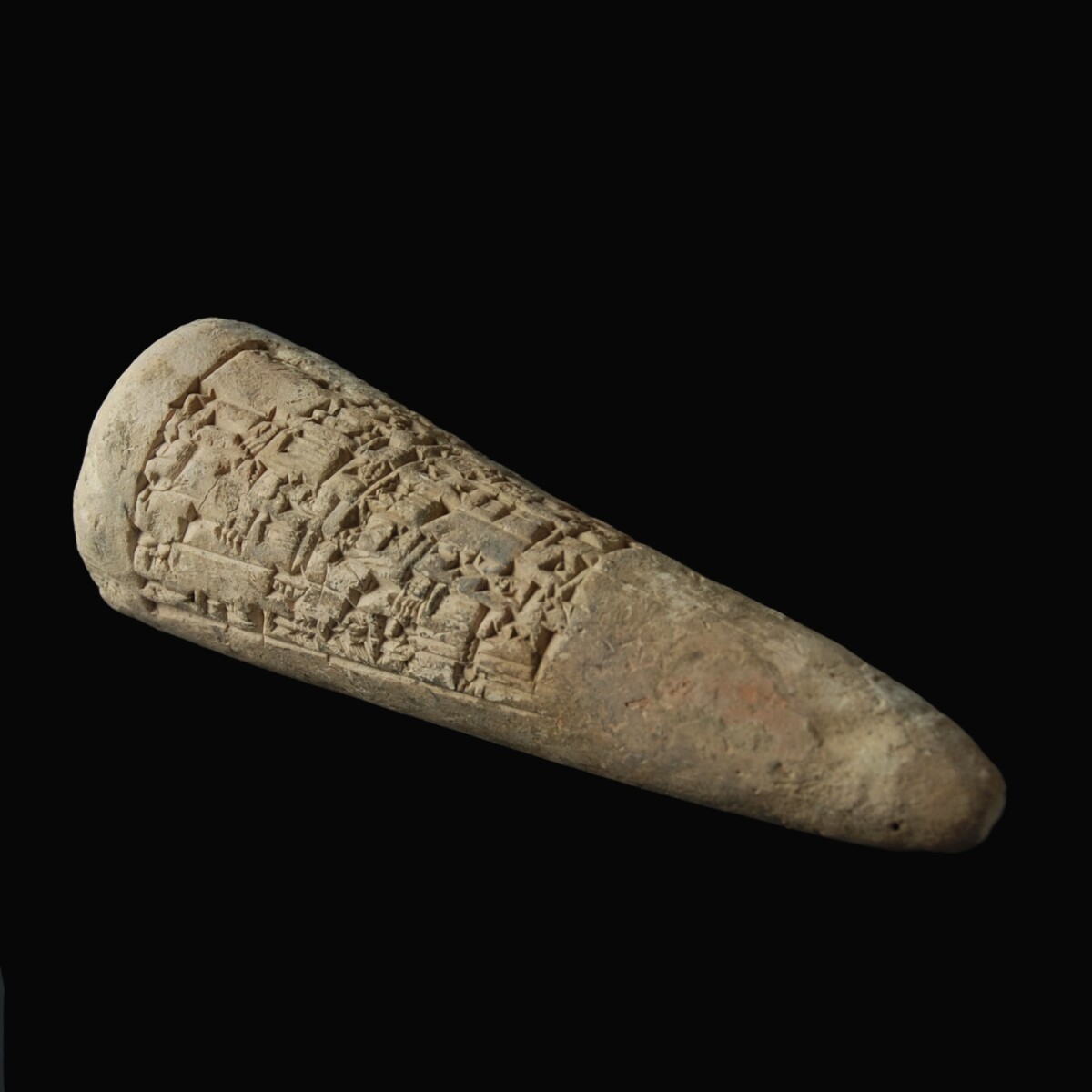
|
|
Southern Mesopotamia – 1953-1935 B.C.
|
Foundation cone of light clay with a flat base on the broadside and a rounded tip on the other side. The inscription, covering around three quarters of the cone originates from Ishme-Dagan, the fourth king of I. Dynasty of Isin. He ruled over southern Mesopotamia. This foundation cone certifies that under his reign the city walls of Isin were fortified. The translation of the inscription reads: “When Ishme-Dagan, the strong man, the King of four regions, abolished the tribute of Nippur and freed his soldiers from duty, he built the great rampart of Isin. The name of this rampart is: "Ishme-Dagan is thanks to Enlil the arm of the great An”. Mounted.
|
Provenance: French private collection, 1980s. Thence with Piasa auction in Paris on 25 November 1996, lot 126.
Dimensions: 13.2 cm long
Price: 3 600 Euro
|
|
|
Südliches Mesopotamien – 1953-1935 v. Chr.
|
Gründungsnagel aus hellem Ton mit einem flachen Ende auf der Breitseite und einer abgerundeten Spitze auf der anderen Seite. Die Inschrift, die etwa dreiviertel des Nagels umlaufend bedeckt, stammt von Išme-Dagān, dem vierten König der I. Dynastie von Isin. Er herrschte über das südliche Mesopotamien. Dieser Gründungsnagel bezeugt, dass unter seiner Herrschaft die Stadtmauern von Isin verstärkt wurden. Die Übersetzung der Inschrift lautet: „Als Isme-Dagan, der starke Mann, der König von vier Regionen, den Tribut von Nippur abschaffte und seine Soldaten vom Dienst befreite, baute er den großen Wall von Isin. Der Name dieses großen Walles lautet: Isme-Dagan ist dank Enlil der Arm des großen An“. Gesockelt.
|
Provenienz: Französische Privatsammlung 1980er Jahre. Danach bei Piasa Auktion in Paris am 25. November 1996, Los 126.
Länge: 15,5 cm
Preis: 3.600 Euro
|
|
|
|
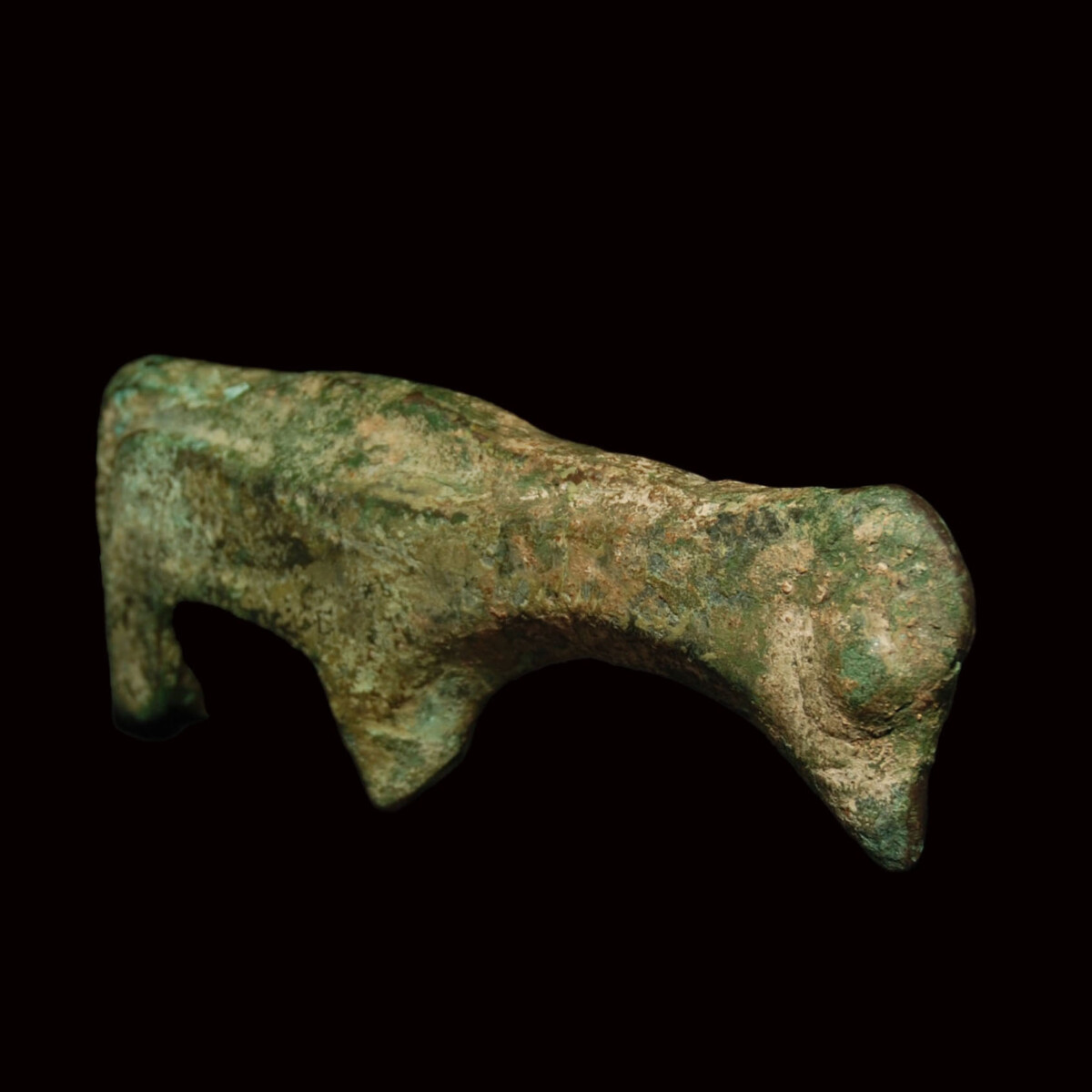
|
|
|
|
|
|
Eastern Iran – 9th century B.C.
|
Large and massive cast bronze statuette of a grazing animal, probably a sheep, from the eastern Iranian cultural region. The animal worked out in early geometric style, with short, tapering legs, a long neck and a massive, downwards facing bird head. The large, round eyes are bulging, the strong neck is overlong. At the back the enclosed tail hangs at the right angle. The flanks on the sides of the animal are flattened. The exceedingly heavy statuette is semi-circularly hollow between the legs, where it possibly was mounted on a backrest and served as a hand rest. But also possible is that the statuette of a grazer was sacrificed as an important votive offering.
|
Provenance: From the US art market, acquired in the early 2000s.
Dimensions: 16 cm long
Price: 1 600 Euro
|
|
|
Ostiran – 9. Jahrhundert v. Chr.
|
Große und massiv gegossene Bronze-Statuette eines Weidetieres, wohl eines Schafes, aus dem ostiranischen Kulturraum. Das Tier im frühgeometrischen Stil gearbeitet, mit kurzen, spitz zulaufenden Beinen, einem langen Hals und einem mächtigen, nach unten gewandten Vogelkopf. Die großen, runden Augen quellen hervor, der kräftige Hals ist überlang. Hinten fällt der anliegende Schwanz im rechten Winkel herab. Die seitlichen Flanken des Tieres sind abgeflacht. Die überaus schwere Statuette hat eine halbrunde Aushöhlung zwischen den Beinen, über die sie möglicherweise auf einer Sitzlehne montiert war und als Handablage diente. Denkbar ist aber auch, dass die Statuette eines Weidetiers als bedeutende Votivgabe geopfert wurde.
|
Provenienz: Aus dem amerikanischen Kunsthandel, erworben Anfang der 2000er Jahre.
Länge: 16 cm
Preis: 1.400 Euro
|
|
|
|
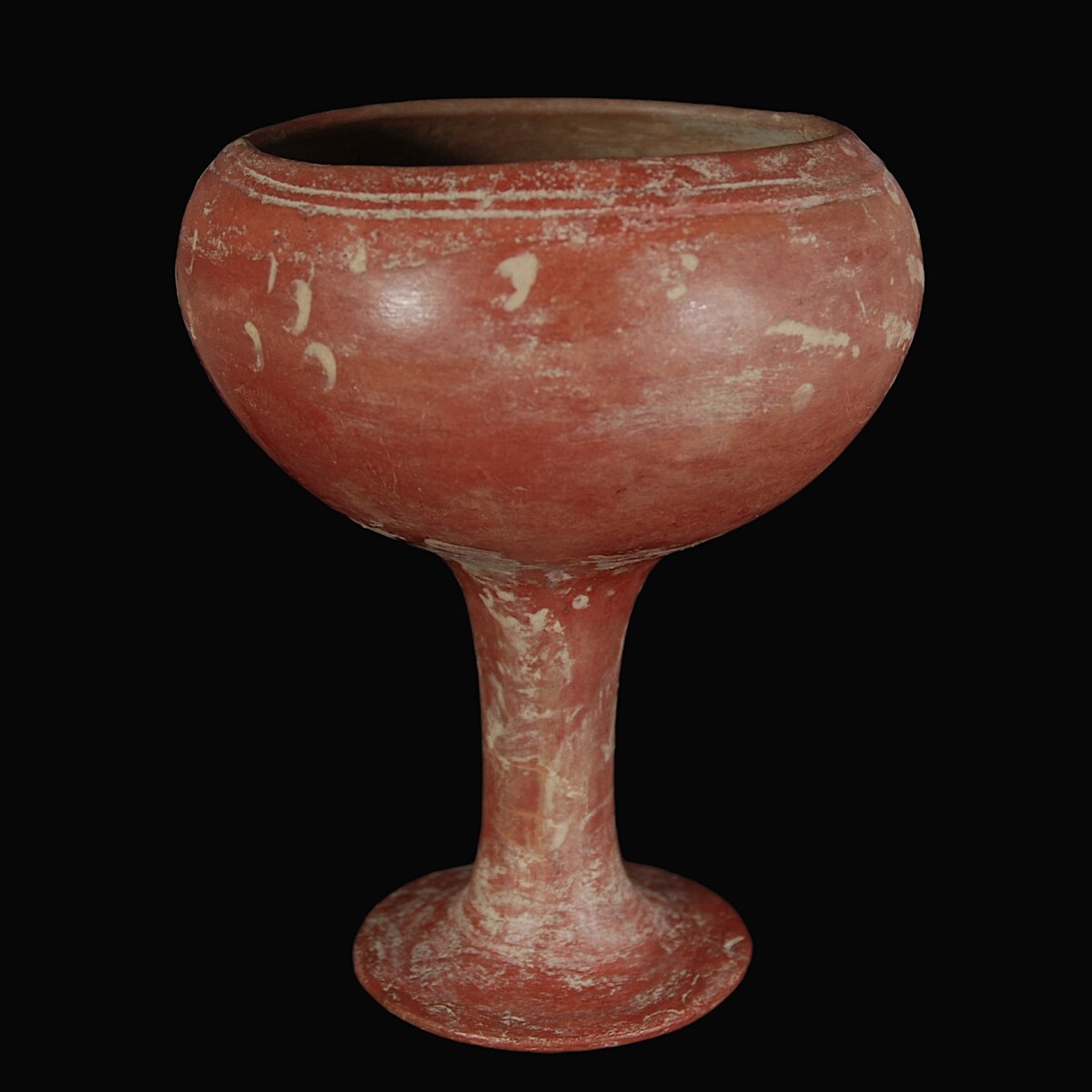
|
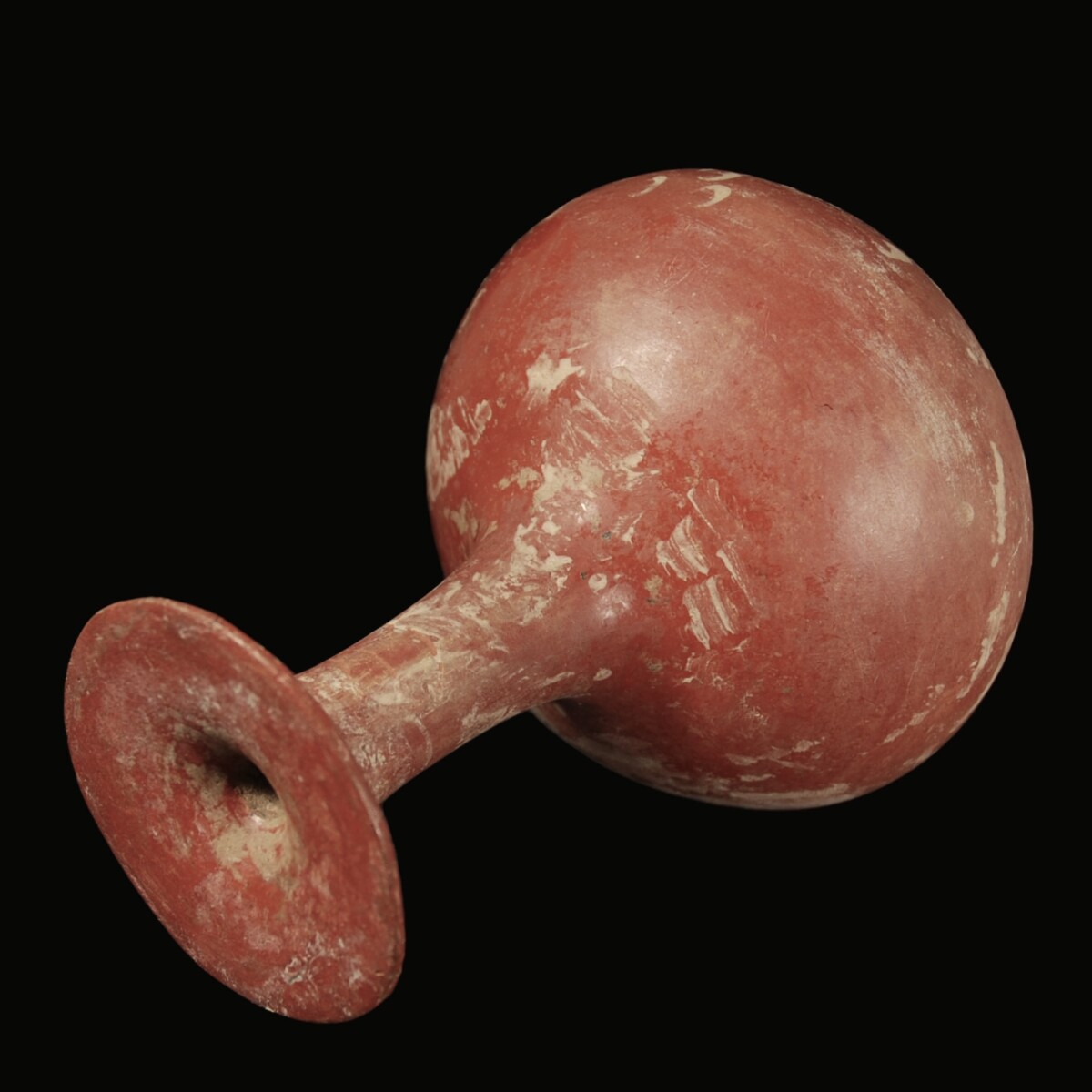
|
|
Urartu – 7th century B.C.
|
Large chalice of the Urartian Red Polished Ware (Toprakkale pottery) on a high, trumpet-shaped foot, which is hollow on the inside up to the base of the bowl. The surface is covered with a slip (clay glaze) of red clay and finely polished, possibly with leather. The massive bowl itself is semi-circular and far protruding with an inwardly curved rim. Right under the rim two encircling, incised circles. A rare, elegant form. See for Urartian Red Polished Ware, which was intended to imitate metal and often used as votive offerings in temples: Aylin Ümit Erdem “Urtartian Pottery”, Ege University December 2021, p. 263-266, as well as for chalice-type with a hollow foot ring page 269. See also: Oya San “Urartian Red Burnished Pottery from the Diyarbakir Museum”, p. 77.
|
Provenance: From an old German private collection. Auctioned with Gorny&Mosch on 14 December 2007 (incorrectly described as Roman terra sigillata ware), lot 416.
Dimensions: 16.9 cm high
Price: 1 600 Euro
|
|
|
Urartu – 7. Jahrhundert v. Chr.
|
Großer Kelch der urartäischen Red Polished Ware (Toprakkale-Keramik) auf hohem, trompetenförmigem Fuß, der innen bis zum Schalenansatz hohl ist. Die Oberfläche ist mit einem Slip (Lehmglasur) aus rotem Ton überzogen und fein poliert, vielleicht mit Leder. Die mächtige Schale selbst ist halbrund und weit auslaufend mit einem nach innen gewandten Rand. Gleich unterhalb des Randes zwei umlaufende, eingeritzte Kreise. Eine seltene, elegante Form. Vergleiche zur urartäischen Red Polished Ware, die Metall imitieren sollte und deren Gefäße häufig als Votivgaben in Tempeln geopfert wurden: Aylin Ümit Erdem „Urtartian Pottery“, Ege University Dezember 2021, S. 263-266 sowie zu den Kelchen mit hohlem Standfuß S. 269. Siehe auch: Oya San „Urartian Red Burnished Pottery from the Diyarbakir Museum”, S. 77.
|
Provenienz: Aus alter deutscher Privatsammlung. Versteigert bei Gorny & Mosch am 14. Dezember 2007 (fälschlicherweise als römische Terra Sigillata Ware bezeichnet), Los 416.
Höhe: 16,9 cm
Preis: 1.600 Euro
|
|
|
|

|

|
|
|
|
Roman Empire – February 204 A.D.
|
Fragment of a rare Praetorian diploma dating to the period of Emperor Septimius Severus. It is the upper right corner part of Tabella A. The certificate is to be dated to the annual range between 10 December 203 to 9 December 204 due to the preserved number of the "Tribunicia Potestas" of the Emperor, namely XII in the sixth row. Since the award to the Praetorians normally takes place in February the dating to February 204 is very possible. On the outside nine rows of the constitution are preserved, which can be completely complemented (see publication by Peter Weiß in "Zeitschrift für Papyrologie und Epigraphik Band 134", 2001, pages 269-270. Inside nine rows from the more elusive inscription are also preserved and well readable. At the bottom left soldering material is preserved, with which the diploma was sealed. The present diploma is the earliest known diploma of a Praetorian dating to the period of Septimius Severus and the first one since 184 A.D. In addition to the publication mentioned above, the diploma was also published with Paul Holder "Roman Military Diplomas V", 2006, p. 883, No 452.
|
Provenance: From the German collection Peter Weiß, acquired between 1967 and 2015.
Dimensions: 5 cm x 4.9 cm
Price: 1 600 Euro
|
|
|
Römisches Reich – Februar 204 n. Chr.
|
Fragment eines seltenen Prätorianerdiploms aus der Zeit des Kaisers Septimius Severus. Es handelt sich um das rechte obere Eckstück einer Tabella A. Die Urkunde ist durch die erhaltene Zahl der „Tribunicia Potestas“ des Kaiser, nämlich XII in der sechsten Zeile, auf die Jahresspanne 10. Dezember 203 bis 9. Dezember 204 zu datieren. Da die Verleihung an die Prätorianer normalerweise im Februar erfolgte, ist eine Datierung in den Februar 204 sehr wahrscheinlich. Außen sind neun Zeilen der Konstitution erhalten, die sich komplett ergänzen lassen (siehe Publikation von Peter Weiß in Zeitschrift für Papyrologie und Epigraphik Band 134, 2001, Seiten 269-270). Von der flüchtigeren Inschrift innen sind ebenfalls neun Zeilen erhalten, die gut lesbar. Innen links unten sind Auflagen der Lötmasse erhalten, mit denen das Diplom verschlossen wurde. Das vorliegende Diplom ist das früheste bekannte Prätorianerdiplom aus der Zeit des Septimius Severus und das erste seit 184 n. Chr. Neben der oben erwähnten Publikation ist das Diplom auch bei Paul Holder „Roman Military Diplomas V, 2006, S. 883, Nr 452 veröffentlicht.
|
Provenienz: Aus der deutschen Sammlung Peter Weiß, erworben zwischen 1967 und 2015.
Dimensionen: 5 cm x 4,9 cm
Preis: 1.600 Euro
|
|
|
|
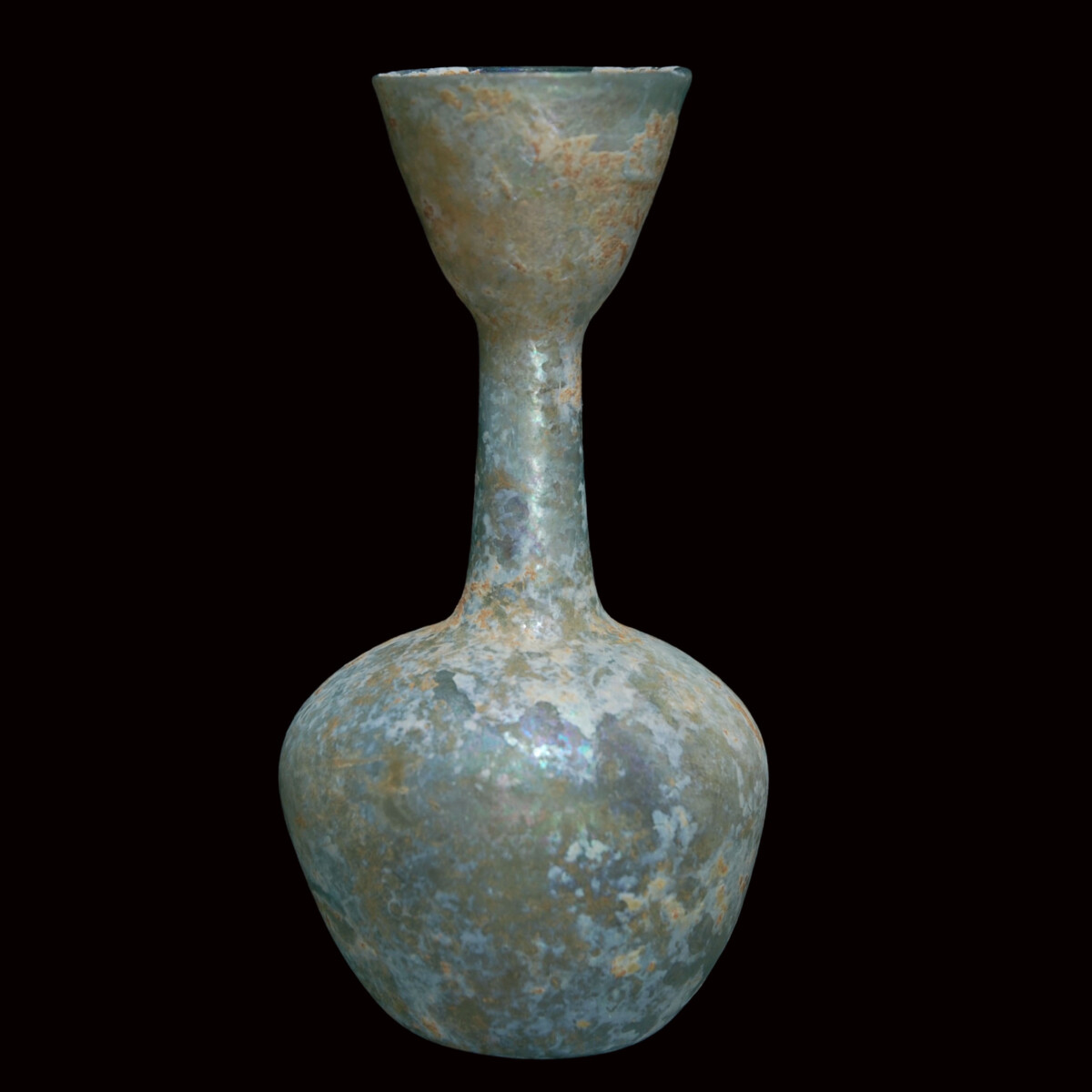
|
|
|
|
Roman Empire – 4th century A.D.
|
Roman glass flask with a magnificent silver colored iridescence and a funnel-shaped estuary. The bulbous corpus with a flat shoulder, the base dented. From the eastern Mediterranean region. At the bottom an old collection number is tinyly written with a black pen.
|
Provenance: Private collection Dr. Eugene Elovic, Miami Beach, USA. Thence in the Israeli art market.
Dimensions: 14.8 cm high
Price: 900 Euro
|
|
|
Römisches Reich – 4. Jahrhundert n. Chr.
|
Römische Glasflasche mit herrlicher silberfarbener Irisierung und trichterförmiger Mündung. Der bauchige Korpus mit flacher Schulter, der Boden nach innen gewölbt. Der Hals ist lang und verjüngt sich leicht nach oben. Daran anschließend die große trichterförmige Mündung. Aus dem östlichen Mittelmeerraum. Auf der Unterseite ist winzig eine alte Sammlungsnummer mit schwarzem Stift aufgeschrieben.
|
Provenienz: Privatsammlung Dr. Eugene Elovic, Miami Beach, USA. Danach im israelischen Kunsthandel.
Höhe: 14,8 cm
Preis: 900 Euro
|
|
|
|
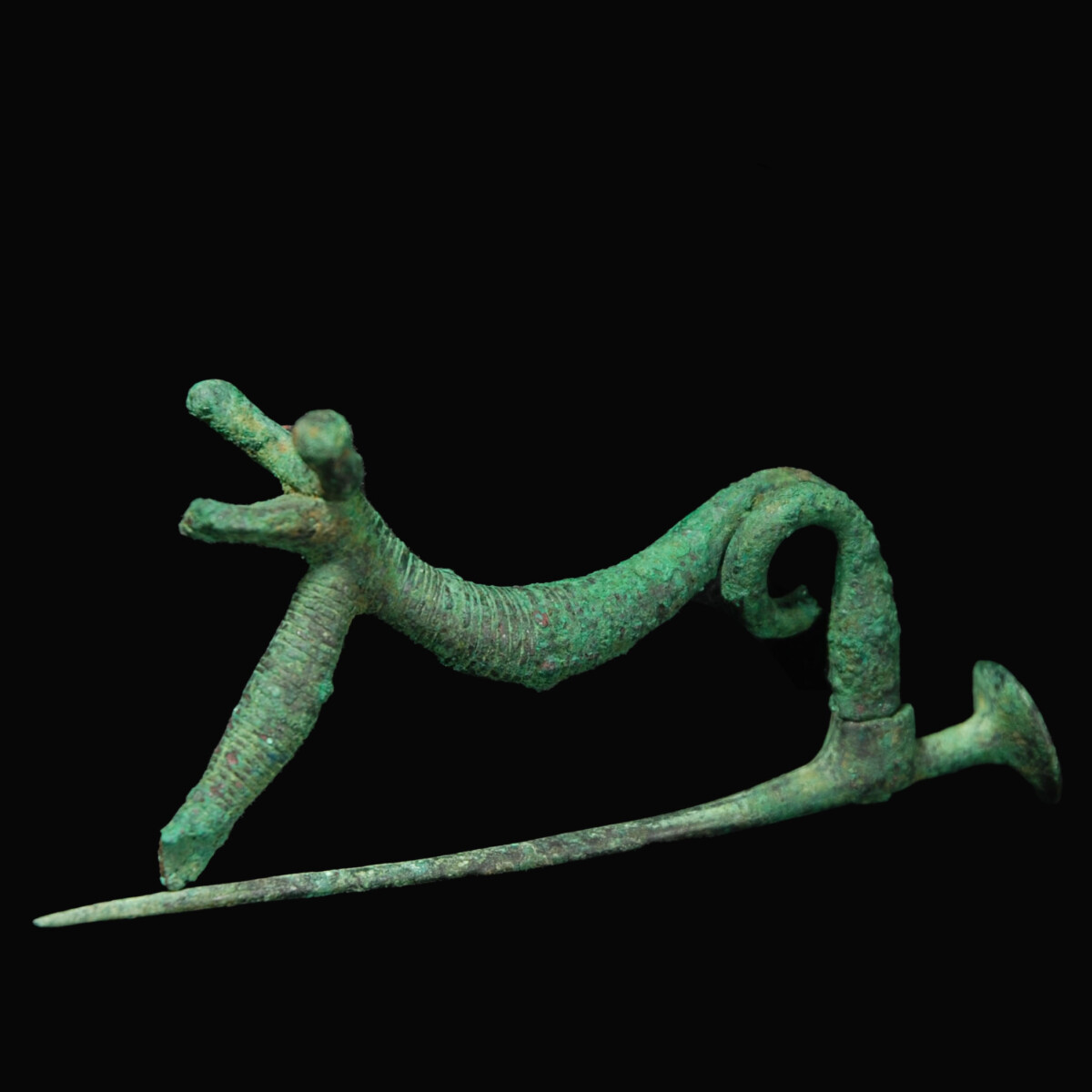
|
|
|
|
|
|
Middle Europe – 6th-5th century B.C.
|
Bronze fibula in form of a stylized bull, worked out from two parts, dating to the late Hallstatt period. The body, which at the same time serves as the bow, runs in the back in a loop where a vertical tenon sticks out. On this tenon is a separately worked out needle with a disk head riveted. The bull himself with rounded horns, a flat snout and a body grooved throughout. The foreleg possibly had a catch plate, which is missing today. A rare, very interesting example. Possibly from Slovenia or Friuli.
|
Provenance: From the old London collection D. D., acquired between 1975 and 1980. Thence Gorny & Mosch Auktion on 16 December 2015, lot 212.
Dimensions: 12.5 cm long
Price: 800 Euro
|
|
|
Mitteleuropa – 6.-5. Jahrhundert v. Chr.
|
Aus zwei Teilen gearbeitete, spät-hallstattzeitliche Bronze-Fibel in Form eines stilisierten Stieres. Der Körper, der gleichzeitig als Bügel dient, geht hinten in eine Schlaufe über, von der ein vertikaler Zapfen absteht. An diesen Zapfen ist die separat gearbeitete Nadel mit Scheibenkopf angenietet. Der Stier selbst mit abgerundeten Hörnern, flacher Schnauze und einem durchgehend gerillten Körper. Der Vorderlauf besaß möglicherweise noch einen Nadelhalter, der heute fehlt. Ein seltenes, sehr interessantes Exemplar. Wohl aus Slowenien oder Friaul.
|
Provenienz: Aus alter Londoner Sammlung D. D., erworben zwischen 1975 und 1980. Danach Gorny & Mosch Auktion vom 16. Dezember 2015, Los 212.
Länge: 12,5 cm
Preis: 800 Euro
|
|
|
|
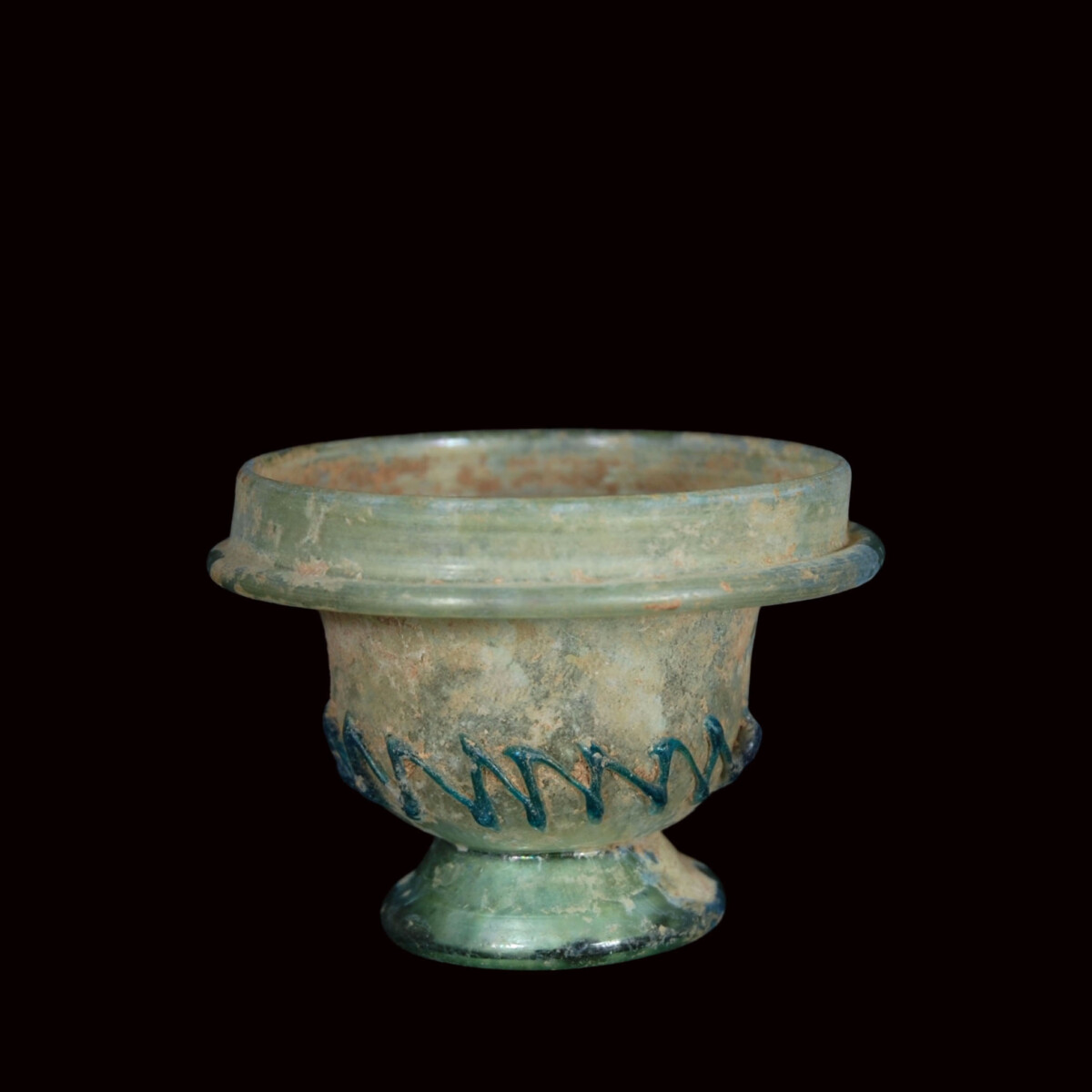
|
|
Roman Empire – 2nd half of 4th century A.D.
|
Collared rim bowl of greenish shimmering clear glass on a set off foot with a thickened foot ring. The corpus tapering downwards and decorated with a dark green glass thread in a zig zag pattern. The rim is also rounded, below a narrow, closed and swaged collar. From Palestine. The form of the bowl dates to the 1st and 2nd century. In the 4th century the form was revived in Israeli workshops and extended with a set off ring foot and decoration threads.
|
Provenance: Israeli collection Z. Holtzmann, Tel Aviv.
Dimensions: 5.6 cm high
Price: 900 Euro
|
|
|
Römisches Reich – 2. Hälfte 4. Jahrhundert n. Chr.
|
Schale aus grünlich schimmerndem Klarglas auf abgesetzten Fuß mit verdicktem Standring. Der Korpus verjüngt sich nach unten und ist umlaufend mit einem dunkelgrünen Glasfaden im Zickzackmuster verziert. Der Rand ist ebenfalls abgerundet, darunter ein schmaler, geschlossener und gestauchter Kragen. Aus Palästina. Die Form der Kragenschale datiert aus dem 1. und 2. Jahrhundert. Im 4. Jahrhundert wurde die Form in israelischen Werkstätten wieder aufgenommen und durch abgesetzte Standfüße und Zierfäden erweitert.
|
Provenienz: Israelische Sammlung Z. Holtzmann, Tel Aviv.
Höhe: 5,6 cm
Preis: 900 Euro
|
|
|
|
|
|
|
|
|
CHRISTOPH BACHER ARCHÄOLOGIE ANCIENT ART GmbH
|
Galerie: Stubenring 20, A-1010 Wien
Showroom: Untere Viaduktgasse 55, A-1030 Wien
|
|
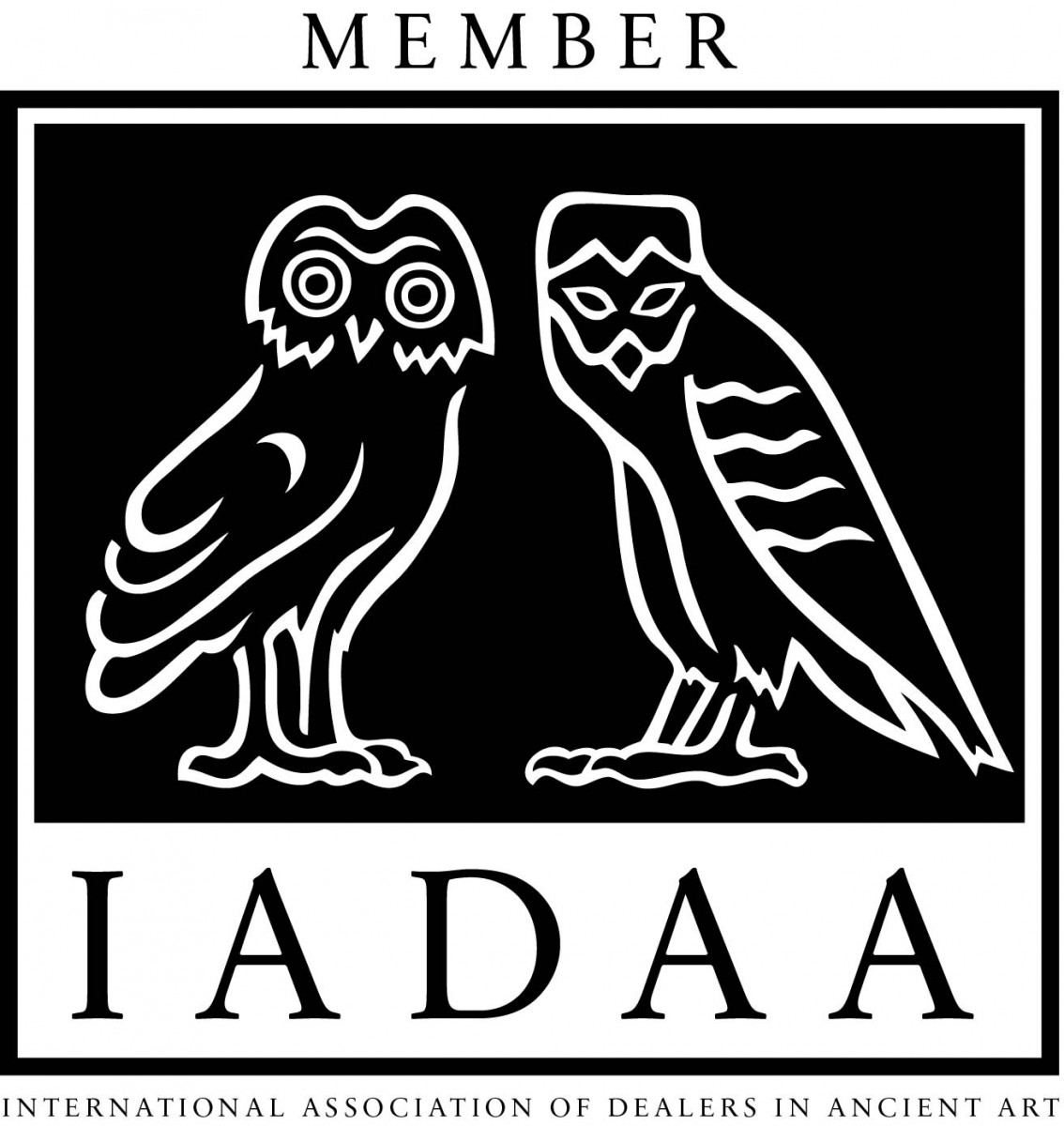
|
|
|
|




